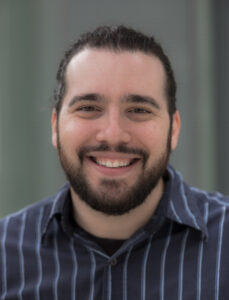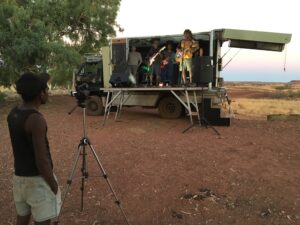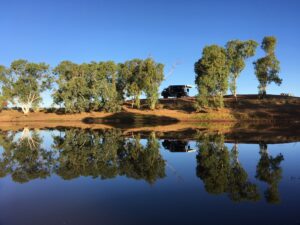Engaged Anthropology Grant: William Lempert
 Dr. William Lempert received a Dissertation Fieldwork Grant in 2015 to aid research on “Broadcasting Indigeneity: The Social Life of Aboriginal Media,” supervised by Dr. Jennifer Shannon. In 2019, Dr. Lempert returned to the field when he received an Engaged Anthropology Grant to aid engaged activities on “Palya Collaboration: After-Images and Visual Sharing in the Social Life of Kimberley Aboriginal Media.”
Dr. William Lempert received a Dissertation Fieldwork Grant in 2015 to aid research on “Broadcasting Indigeneity: The Social Life of Aboriginal Media,” supervised by Dr. Jennifer Shannon. In 2019, Dr. Lempert returned to the field when he received an Engaged Anthropology Grant to aid engaged activities on “Palya Collaboration: After-Images and Visual Sharing in the Social Life of Kimberley Aboriginal Media.”
With the Engaged Anthropology Grant, I was able to return to the Kimberley region of Northwestern Australia in July-August to share the results of my primary dissertation fieldwork that took place during 2014-2016. This fieldwork includes a total of 30 months since 2006 with two Indigenous media organizations in the coastal pearling town of Broome, as well as in regional communities. Throughout this period, I followed the lifecycles of dozens of film projects through daily collaboration within production teams in order to understand the stakes of Aboriginal self-representation embedded within the process of filmmaking itself.
The projects I collaborated on included a wide variety of genres and topics, from documentaries following Dreaming stories and Songlines, to clay animation and music videos. These projects were broadcast locally, as well as broadly on National Indigenous Television and Community Indigenous Television. I was particularly focused on the relationship between the production of films that vividly imagine hopeful and diverse Indigenous futures, and the widespread defunding of Aboriginal communities and organizations.
Completing this trip was central to my primary goal of ethnographic practice: to engage at the deepest level of collaboration possible. This approach led me—after multiple consultation trips in 2012 and 2013—to follow the social lives of media projects at Goolarri Media Enterprises (Goolarri) and the Pilbara and Kimberley Aboriginal Media Association (PAKAM). I followed the biographical social lives of interconnected film projects from their initial idea through their circulation and beyond. In my dissertation, I discuss the Kukatja concept of “palya,” which translates to something done “the good and right way,” with an emphasis on process. Thus, my return in 2019 represented the completion of this process and the commitment I made with my collaborators.
In Broome, I hand delivered copies of my dissertation to key individuals at Goolarri and PAKAM, and discussed the next stage of turning it into a book. Their feedback was invaluable, and these dialogues will continue over the coming years. I was also interviewed twice by local radio legend Sandy Dann on Goolarri Radio; our discussion on the broader themes of my research was broadcast widely over the National Indigenous Radio Service.
I have worked with the Nulungu Research Institute through the University of Notre Dame Broome Campus since 2012. During this recent trip, I presented an hour-long lecture through their “Talking Heads” public seminar series, located just across the street from Goolarri and PAKAM. This series emphasizes plain spoken discussions of long-term regional research and provided a forum to articulate my ethnographic results to the broader Broome community.
As a PAKAM volunteer, I drove their Toyota Land Cruiser from Broome to Balgo—my second primary fieldsite—located in the Great Sandy Desert of Western Australia. I gave copies of my dissertation to key collaborators, including Kukatja elder Mark Moora, women elders at the Kapululangu Women’s Law and Culture Centre, and community members at the art center. We discussed the process of developing this into a book over the coming years.

As part of my volunteer work in Balgo, I collaborated on a community men’s health and music project. This centered around a trip out of Balgo with a large 4WD truck—built and operated by Broome musician Staf Smith—that ran on solar power and vegetable oil, and which transformed into a powered mobile music stage. Local musicians played above a waterhole to their brothers and cousins, who were cooking dozens of kangaroo tails in an earthen oven nearby. The musicians played on this stage around the community—including locations like the basketball court and the art center—and recorded their songs in the local music studio. I worked with Staf and the local PAKAM media crew to integrate this audio and footage into an extended music video, which aired nationally on Indigenous Community Television.

Since last visiting Balgo, I completed final video editing for multiple films featuring local hand signs, which I had facilitated with community members through PAKAM and National Indigenous Television (NITV). I held multiple screenings in Balgo that included the official community premiere of these programs. Following proper cultural protocols, I first held a private screening at the women’s center, which included the elders most closely involved with the projects. After that, I organized a community film festival featuring these and several of our other collaborative media projects from the last several years. This provided an interactive forum to watch and reflect on our past videos, as well as to consider ideas for future projects.
Visual sharing was an essential part of this return trip, as it provided key opportunities for engagement that were inclusive and aligned with the “palya” process. As I describe in my dissertation, the social lives of films do not simply end when they have been screened and circulated. Rather, they often give birth to “after-images,” which are new projects and ideas that have other multiple and rippling lives. Thus, my dissertation and this follow up trip represent such after-images, which are themselves embedded within the social lives of these media.